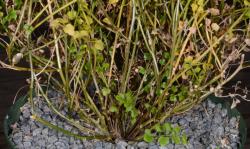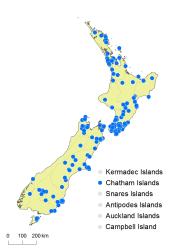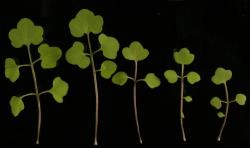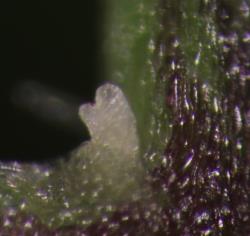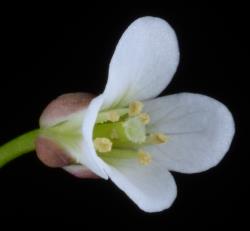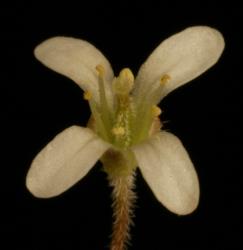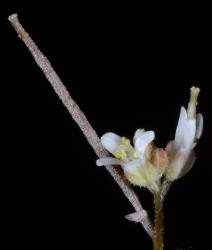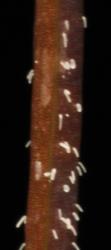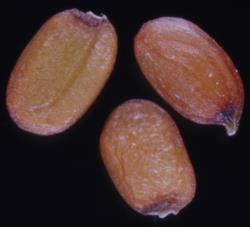- ≡ Sisymbrium heterophyllum G.Forst., Fl. Ins. Austr. 46 (1786)
- ≡ Cardamine heterophylla (G.Forst.) O.E.Schulz, Bot. Jahrb. Syst. 32: 487–488 (1903) nom. illeg., non Cardamine heterophylla Host 1797
Perennial herb, single rosette or several rosettes with short lateral branches. Leaves up to 110 mm long, pinnatisect; lamina 30.0–68.0 × 15.0–36.0 mm, light green to green, membranous, glabrous to sparsely or moderately hairy on abaxial surface, glabrate or sparsely to moderately hairy on adaxial surface, margin and petiole; hairs 0.2–0.6 mm long, retrorse, spreading, solitary or occasionally in pairs; hydathode in leaflet axil, up to 0.3 mm long; petiole up to 48 mm long. Terminal pinna 3.5–21.0 × 4.7–23.0 mm, simple, broadly orbicular or broadly deltoid; margin entire to often deeply lobed, often irregular in shape, with 2–4 distinct hydathodes; apex obtuse with a distinct hydathode; base cordate or truncate. Lateral pinnae 2–6, 2.0–20.0 × 2.0–15.0, broadly orbicular, broadly elliptic-orbicular or broadly deltoid; apex obtuse with a distinct hydathode; base shallowly cordate, ± truncate to obtuse, sometimes oblique; petiolule 2.0–8.0 mm long. Cauline leaves similar to rosette leaves but smaller, narrower, with fewer lateral pinnae, distinctly lobed, pinnae bases attenuate to obtuse, terminal pinna up to 20.0 × 20.0 mm, lateral pinnae up to 13.0 × 11.0 mm. Inflorescence racemose, sometimes with lateral racemes, each raceme 3–6-flowered; peduncle up to 750 mm long, 0.8–1.1 mm diam. at base, spreading to ascending, glabrous to sparsely or moderately hairy. Pedicels 1.2–8.5 mm long, 0.15–0.25 mm diam., glabrous or moderately to densely hairy, hairs retrorse. Sepals 1.3–1.6 × 0.5–0.7 mm, elliptic-oblong, saccate, green to red-brown, sparsely hairy, hairs spreading to patent, margin white and membranous, apex obtuse to subacute, base truncate. Petals 3.0–4.5 × 0.7–1.4 mm, white, limb narrowly obovate; apex obtuse; base attenuate, tapering to a c. 0.1 mm-long claw. Stamens 6; median filaments 4, 1.6–2.5 mm long; lateral filaments 2, 1.6–2.0 mm long; anthers 0.2–0.3 mm long, cream to pale yellow, when dehiscent held at a similar height to or slightly above the stigma. Ovary 1.5–2.5 mm long, 0.3–0.5 mm diam., ± terete, green, usually densely hairy; hairs <0.15 mm long, retrorse; ovules 18–22; style 0.2–0.3 mm long, ± terete; stigma 0.4–0.6 mm diam. Siliques 20.0–37.0 × 0.7–1.1 mm, style 1.2–1.4 mm long; valves purple-brown or green-brown at maturity and when dehiscent, glabrous or sparsely to moderately hairy; hairs retrorse, 0.15–0.35 mm long; replum 0.2–0.4 mm wide, glabrous or sparsely hairy. Seeds 1.2–1.4 mm long, 0.6–0.9 mm wide, 0.3–0.4 mm thick, oblong to broadly oblong, henna; wing absent.
North Island: Northland, Auckland, Volcanic Plateau, Gisborne, Taranaki, Southern North Island.
South Island: Western Nelson, Sounds Nelson, Westland, Marlborough, Canterbury, Otago, Southland, Fiordland.
Stewart Island.
Chatham Islands: Chatham Island.
Cardamine forsteri is widespread throughout New Zealand, including the North Island, South Island, and Chatham Islands. Cardamine forsteri comprises glabrous and hairy silique forms, and both are widely distributed in New Zealand.
Cardamine forsteri occurs in a wide variety of habitats, including moist or dry soils in open, grazed and/or disturbed areas of coastal and lowland forest, among seabird burrows on peaty soils (e.g., Herekopere Island), on or around rocky bluffs, amongst tussocks and scrubland, and in stream and river beds (Heenan 2017). Cardamine forsteri also shows a preference for base-rich substrates such as limestone and sandstone.
Cardamine forsteri is assessed as having a conservation status of Not Threatened (de Lange et al. 2018).
Flowering August–April; Fruiting October–May.
Silique valve hairs vary throughout the distributional range, with plants either having hairy or glabrous siliques. This variation can occur with close geographic proximity, with, for example, plants from Pareora River gorge population (Canterbury) having mostly hairy silique valves but also some plants with glabrous valves. Flower colour is typically white, but collections with lilac-pink petals have been made from Upper Hutt, Wellington (CHR 82837, A. P. Druce s.n.; CHR 567795, P. Enright s.n.).
The presence of axillary leaflet hydathodes is an important character of Cardamine forsteri. However, their presence can vary as they are caducous, and so careful searching of the leaf axils is often needed to locate persistent hydathodes, especially on older leaves. A number of plants with young leaves in good condition collected from the western Wellington coast appear not to have axillary hydathodes, but in all other respects these plants have characters consistent with C. forsteri.
Plants included in Cardamine forsteri have previously been known by the tagnames C. "narrow petal" (Pritchard 1957; Allan 1961; Webb et al. 1988), C. "(b) slender var." (Allan 1961; Webb et al. 1988), C. "Wakatipu minute flower" (Druce 1993), and C. "Reporoa Bog" (CHR!). Plants that have been previously referred to C. "slender var." and C. "Reporoa Bog" are typically mature plants that are characterised by multiple stems and the absence of basal and lower cauline leaves, but they also have siliques clustered at the distal part of the inflorescences, lobed leaflets, sometimes hairy siliques and leaflets with axillary hydathodes (all features of C. forsteri).



